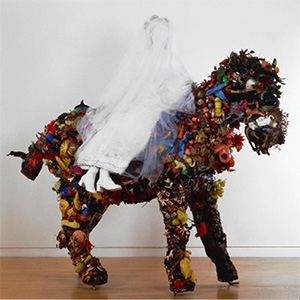
Gender Roles
"Look at my Brides, they may be beautiful but [they are] also painful. They reflect the feminine condition."—Niki de Saint Phalle(1)
Niki de Saint Phalle
The Horse and the Bride (Cheval et la Mariée), 1963
Toys, kitchen utensils, ornaments, plastic flowers, and wire mesh, 235 x 300 x 120 cm
Sprengel Museum, Hannover, inv. SH 87,2001, Gift of the artist, 2000
Introducción
By the end of 1963, Niki de Saint Phalle (b. 1930, Neuilly-sur-Seine, France; d. 2002, La Jolla, California) began to explore the idea of femininity, the role of women in society and how they are represented. She produced a series of female sculptures depicting mothers, witches, brides, and women giving birth.(2) Saint Phalle believed that femininity was crushed in a society dominated by men, and that this fact needed to be changed.(3) By creating life-size dolls of women, she showed her own depiction and representation of female characters, which questioned and challenged the established female roles.(4)
Between 1963 and 1964 Saint Phalle created a series of sculptures depicting brides. She showed them in different positions, sometimes seated, sometimes on horseback, but always beautiful, passive, and detached from real life—more like fairy-tale princesses.(5) The Horse and the Bride (Cheval et la Mariée), 1963 portrays a bride riding a horse constructed from dozens of toys, kitchen utensils, ornaments, and plastic flowers, which Saint Phalle acquired from stores and supermarkets and assembled by fixing the objects to a mesh structure of chicken wire in the shape of a horse’s body.(6) The white bride was endowed with a sense of purity and innocence, despite the crudeness of her construction.(7) In The Horse and the BrideLa Mariée à Cheval, Saint Phalle contrasted the thin and stiff white body of the bride with a cheerful-looking, colorful horse. She explores the color white, which references an honorable and pure status while it can also appear ghostly and disturbing.
The Horse and the Bride was inspired by the equestrian statues of the Renaissance as well as stories of Saint Phalle’s childhood in which mounted knights on horses saved fragile princesses. By depicting the woman in this way, Saint Phalle intended to provoke the viewer and question the lack of freedom and the constraints of the world around women.
1. “Exclufif. Niki de Saint Phalle, sa dernière interview,” in VSD, May 30, 2002, pp. 19–20.
2. Tate Liverpool, Niki de Saint Phalle: Room 2 www.tate.org.uk/whats-on/tate-liverpool/exhibition/niki-de-saint-phalle/niki-de-saint-phalle-room-guide/niki-de-2
3. “Calling Attention to Art,” interview, 1971 www.youtube.com/watch?v=j1jlKjWRc5Y&index=10&list=PL9LWAQYUI74vXtZkiITcStECDvaNFoUtc
4. “Niki de Saint Phalle, Dossier Pedagogique,” Grand Palais, Galleries Nationales, 2014, p. 12 http://www.grandpalais.fr/pdf/dossier_pedagogique/Dossier_pedagogique_Niki.pdf
5. “Niki de Saint Phalle. Teachers’ Pack,” Tate Liverpool, 2008, p. 5. http://www.tate.org.uk/download/file/fid/6343
6. “Niki de Saint Phalle, Dossier Pedagogique,” p. 12.
7. Tate Liverpool, Niki de Saint Phalle: Room
Preguntas
Show: The Horse and the Bride (1963)
Describe this artwork as thoroughly as possible. Do you notice anything that surprises you? If you had to explain the piece to someone who cannot see it, how would you describe it?
Describe the mood the sculpture conveys. What aspects of the artwork give you this impression?
If the horse and rider in this sculpture suddenly were to come to life, what do you think would happen next? What do you think the horse would do? What about the bride?
For the creation of this sculpture, Niki de Saint Phalle assembled used, found objects that she collected. List the objects you can identify in the structure of the horse. If you needed to collect these objects to create a sculpture, where would you go? Why do you think she chose these materials?
Aside from her own ideals, Saint Phalle found inspiration for this artwork in stories from her childhood. The horses from Saint Phalle’s childhood were the ones found in fairy tales, often related to the figure of the knight or the prince rescuing the princess in distress.(8) Other images she had in mind were of Renaissance equestrian sculptures.(9) Show your students examples of these sculptures (see Resources).
Ask students: What do you notice about these sculptures? Who are these people? What do they have in common? What characteristics do you associate with these riders? Make a list.
Now compare the images with Saint Phalle’s work. What similarities and differences can you find? Can you attribute the characteristics you listed to The Horse and the Bride? Saint Phalle’s bride–rider sculptures represent her ideas of womanhood in society. Why do you think she decided to portray a bride in this way?
8. “Niki de Saint Phalle, Dossier Pedagogique,” p. 12.
9. Ibid.
